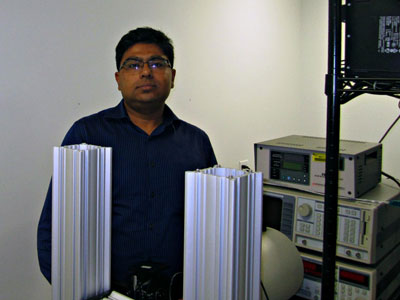| Posted: Jun 07, 2016 |
$1.3 million DARPA grant to fund graphene infrared detector research
(Nanowerk News) The Defense Advanced Research Projects Agency has awarded a $1.3 million grant to a team led by University of Central Florida researcher Debashis Chanda to fund the development of a next-generation infrared detector that could be used in fields as varied as night vision, meteorology and space exploration.
|
|
"We are working on a novel infrared detection and imaging technology. The detection mechanism is very different than what is being used now," said Chanda, an assistant professor with joint appointments to UCF's NanoScience Technology Center and College of Optics & Photonics.
|
 |
| Dr. Debashis Chanda, University of Central Florida
|
|
The work caught the attention of DARPA, which made news recently with fanciful technology like a crewless Navy drone ship, workhorse robots to lug soldiers' heavy gear, and the XS-1 space plane. DARPA is funding the UCF team's research for the 3½ years.
|
|
Portable infrared cameras that can see invisible wavelengths of light have long been used by law enforcement, soldiers, firefighters and others to see in the dark or locate people by the body heat they emit. But the blurry images those devices produce are sometimes nothing more than indistinct colored blobs.
|
|
More powerful infrared detectors that produce more detailed images - ones typically used by NASA and defense agencies - are large, expensive and can only function at ultra-low temperatures.
|
|
"The biggest problem is that most infrared detectors need cryogenic cooling, and in most cases you can't carry a big cooling tank with you," Chanda said. "That is a big barrier."
|
|
Chanda and associate professor Michael Leuenberger of the NTC and UCF's Department of Physics, are working on an entirely new type of detector that relies on a seemingly magic material. The team plans to use a substance known as graphene, that is so thin - just one atomic layer thick - it is a two-dimensional material.
|
|
Chanda envisions an infrared detector that is small, portable, doesn't need to be cooled and produces high-resolution images. Unlike current technologies, which can detect only one band of light, the next-gen detector would be tunable and able to see a range of bands.
|
|
"We came up with the idea that one can make graphene to strongly absorb light in the infrared domain and we showed that we can also tune the response electronically," Chanda said. "If you can take an infrared image in different spectral bands, you can extract much more information."
|
|
The team intends to collaborate with defense majors such as Northrop Grumman, Lockheed Martin and St. Johns Optical Systems for integration and packaging.
|

